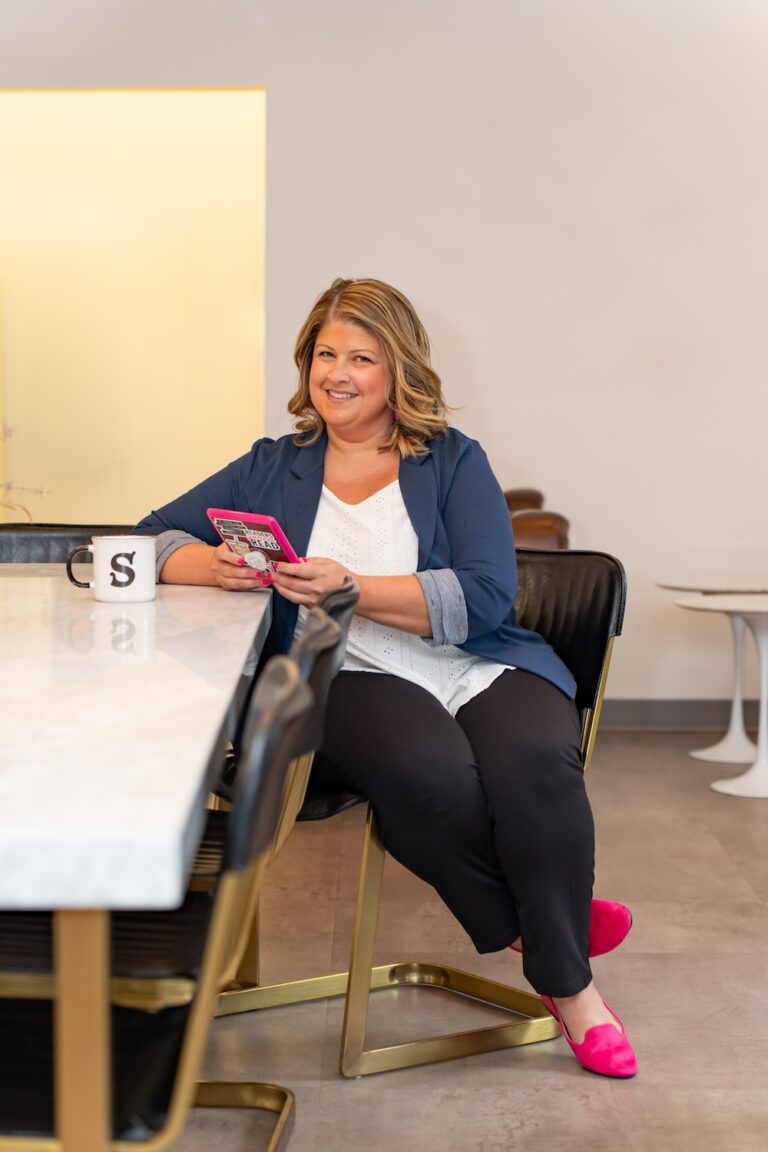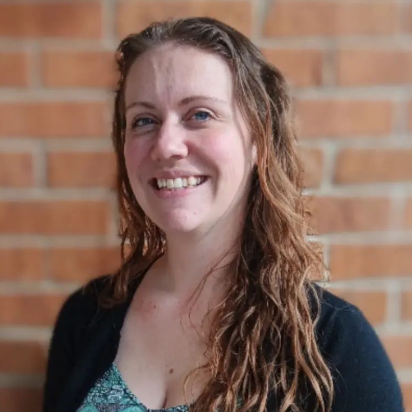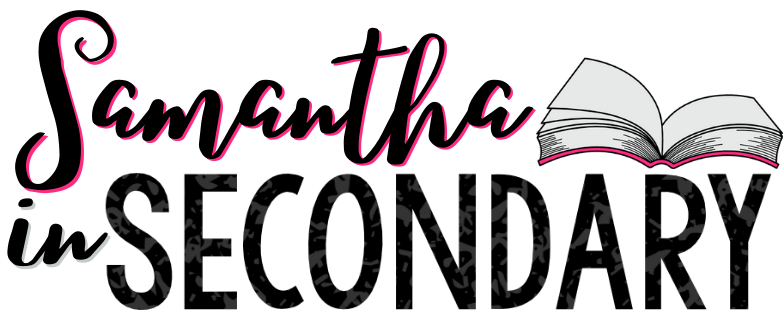Science of Reading isn’t something secondary teachers should skip. If you have struggling readers in your classroom, today’s guest, Allison McManus has tips that you won’t want to miss.
Episode 15
Making Reading Joyful and Effective: The Science of Reading for Older Students with Allison McManus
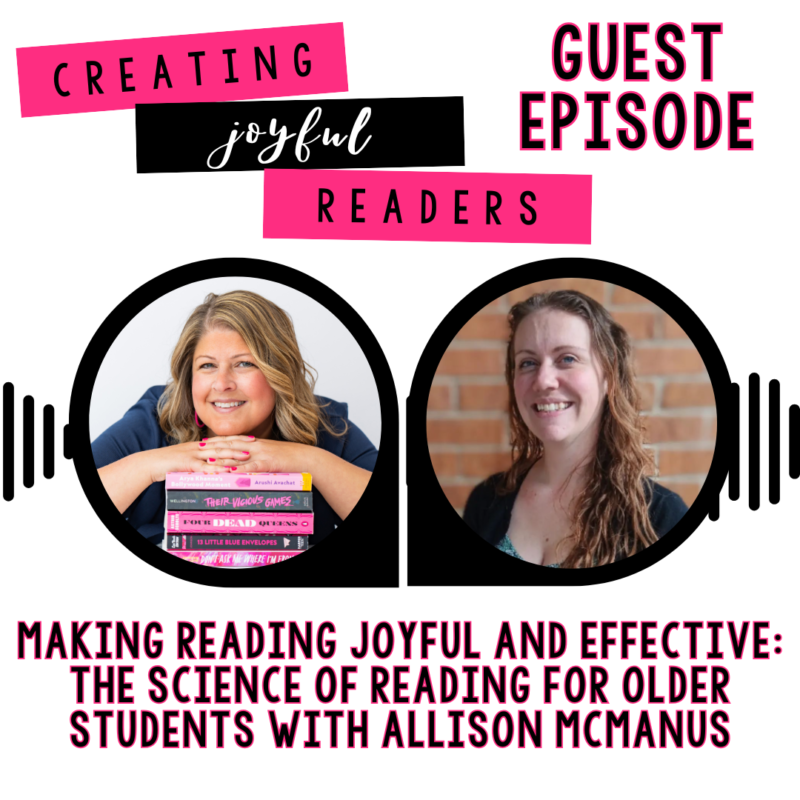
Featured Products
Links & Resources:
Some links referenced here are affiliate links. Supporting the podcast through these links comes at no additional cost to you.
- Science of Reading in Secondary Toolkit – https://mrsmcmanusela.ck.page/sorin2
- Planning a Science of Reading Aligned Unit for Secondary ELA
- Uncovering the Logic of English by Denise Eide – https://amzn.to/4eVS9O5
- The Writing Rope: A Framework for Explicit Writing Instruction in All Subjects by Joan Sedita – https://amzn.to/48oqpPJ
- The Reading Comprehension Blueprint: Helping Students Make Meaning from Text by Nancy Lewis Hennessy – https://amzn.to/4hmESzK
- The Knowledge Gap by Natalie Wexler – https://amzn.to/4hndq5g
- Shifting the Balance, Grades 3-5: 6 Ways to Bring the Science of Reading into the Upper Elementary Classroom https://amzn.to/40PWsGD
Connect with today’s guest:
Follow Allison on Instagram: https://www.instagram.com/mrsmcmanusela/
Allison McManus has been in secondary classrooms since 2012. Shortly after landing her first teaching job, she realized that her degrees in English and secondary education didn’t quite prepare her to help the students that come to her class without basic reading abilities. She has been on an endeavor to figure out how the science of reading research plays a part in secondary classrooms ever since. This, combined with a passion for curriculum, has led to creating and sharing supplemental materials that help students to comprehend the tougher texts that secondary education throws at them. She currently teaches 7th grade English Language Arts and has experience with 6th through seniors.
Prefer to read? Open the transcript here.
Samantha 0:00
Hey, joyful readers, today we’re joined by an amazing guest, Allison McManus, who brings over a decade of experience teaching in secondary classrooms. Allison first started teaching in 2012 and it didn’t take long for her to realize that her degrees in English and secondary education hadn’t fully prepared her for the real challenges she’d face, especially when it came to helping students who struggled with reading. Since then, she’s been on a journey to unlock the science of reading for older students. Her mission is to use this research to guide her curriculum and help students tackle those tough texts that middle and high school throw at them. Now, as a seventh grade ELA teacher with experience teaching everything from sixth graders to seniors, Allison has made it her goal to support both students and teachers with practical research based approaches. I know this conversation with Allison is going to give you plenty of helpful tips and resources to incorporate evidence based reading strategies into your own classroom. Let’s listen in.
Samantha 0:57
Welcome to Creating joyful readers a podcast dedicated to empowering secondary educators with the tools, strategies and inspiration to cultivate a lifelong love of reading in their students. I’m your host, Samantha. Tune in each week as we explore the transformative power of independent reading. Delve into the latest research on literacy, dissect projects that will help your students showcase what they’ve learned in a unique way and share curated recommendations of young adult novels that will captivate and engage your learners. Join in as we embark on a journey to create joyful lifelong readers one book at a time.
Samantha 1:34
Okay, hey, Allison, welcome to the podcast.
Allison 1:36
Hey, thanks. I’m excited.
Samantha 1:38
Thank you so much for your time and for being here to talk to us today. Can you tell us a little bit about your background and how you became interested in the science of reading?
Allison 1:47
So my original degree is in English with secondary certification, and I had like intended to teach high school. I ended up in the middle school setting. I say that because I’m not sure what the difference would have been in my education had I sought out Middle School. But as I’m sure you know, preparing to teach high school meant zero prep for teaching kids to read.
Samantha 2:14
Yes.
Allison 2:15
In fact, my first job, it’s kind of an interesting story. So I’m certified for six through 12 English and social studies. And my first job was, kind of, we got to fill a space really fast situation. So I was brought on kind of last minute as a sixth grade social studies teacher and, like, reading interventionist.
Samantha 2:35
Yeah.
Allison 2:36
It was a really bonkers situation.
Samantha 2:39
Doesn’t it always turn out that way?
Allison 2:42
I mean, like, nobody with that certification is qualified as an interventionist, but I was thrown in in the situation, and I had to figure out how to help my students with foundational reading skills. Unfortunately for them, I didn’t discover the science of reading research until many years later. It was actually a principal at the elementary school in the district that I currently work at that offered to pay for my letters training. So I don’t even know what letters stands for, but it’s a program that, like people use at elementary level to get us started with science of reading, and that really got the ball rolling for me. I actually have a blog post about, like, I call it my SOR origin story about how I got to this place. It involves a lot of Googling and, like, just reading trial and error with my kids. It’s tough, like, how do we get the kids to comprehend? Everything says, you know, like, comprehension strategies, but what does that mean? So it was a lot of like, just, what am I doing? And a lot of PD books, and I finally found science of reading for secondary level, and that’s that’s where I’m at.
Samantha 4:04
Right. So we’re talking about science of reading today, and this episode, can you let our listeners know, what exactly is science of reading?
Allison 4:13
Yeah, so the science of reading refers to a body of research that explains how our brains learn to read. The idea that reading isn’t rocket science has been around forever, but advances in science and brain research prove that, like it is actually rocket science. I don’t remember who wrote that article, but we could look it up. The process that our brains go through as we read is really complex. Some brains automatically, they’re going to get it because they can make those pathways themselves, but some of us need a much more structured approach. So the science of reading is just that framework for how readers learn and then become more capable readers as the texts get more difficult.
Samantha 5:08
Awesome. So can you tell me a little bit about how science of reading is different from traditional reading instruction?
Allison 5:16
So honestly, it’s not. It comes down to priorities. I personally think that, like we as secondary teachers, like we definitely don’t know how to teach phonics, but the components that we do know how to do, like grammar and syntax and vocabulary and building background knowledge, those are the things like we know to do them. . . we just don’t necessarily make them a priority, or we leave them to last, and then we run out of time. But those are the things that make it so we can comprehend. The biggest difference between, like, how I taught before I found SOR and Scarborough’s reading rope is now I systematically insert those components of the reading rope into my day to day. I don’t leave grammar for the end of a long unit. I don’t do writing units like we do writing within the reading units. I don’t let things get left till the end, because it’s not different. If we know what to do and we find the time to do it that’s going to help our kids comprehend.
Samantha 6:27
Can you tell me a little bit about the reading rope that you were just talking about?
Allison 6:31
Yeah, for sure. So Scarborough’s reading rope came out in like 2001 and it has phonics on there. So like it is the foundation. Phonics is a thing. We know that. But then as kids get more strategic and more skilled at reading, it also brings in grammar and syntax, vocabulary, whether or not they have the breadth of vocabulary that they need. It’s got background knowledge, verbal reasoning, and just like basic literacy knowledge, you don’t think about the fact that they might not know what transition words are. So we have to explicitly teach that. And that’s something that, like blew my mind whenever I started at high school, and then I’m here in middle school, I have to teach that. And if we don’t make sure that everyone is getting those foundational skills as they grow as readers, and especially like you know, if kids are moving around and they’re not at the same district from sixth to seventh grade. Did they learn this in sixth or do I need to teach it now? It just gets very tricky, those foundational skills.
Samantha 7:51
So why is this science of reading stuff important? I mean, shouldn’t kids be learning to read when they’re in the lower grades? As a secondary teacher, why are we hearing about this now? And you know, what do you think? Why do you think it’s so important?
Allison 8:05
So it is elementary like we learn to read in elementary school. That is true, but it’s so much more than just decoding the words. We definitely have phonics. Decoding words is like the foundation, but after that, we have to be able to decode sentences, that’s grammar and syntax, and then we get into understanding paragraphs. I mean, they’re doing that at the elementary school, but you think about the difference between the books that we read to our babies to the books that we’re throwing at them in seventh grade and then high school. Those aren’t the things that they’re going to be capable of reading. We haven’t touched on fluency, but if we think about how kids read fluently at the elementary school level, and then we throw like Shakespeare at them, or that’s not a good example, because that’s a whole different language, right?
Samantha 9:06
Yeah,
Allison 9:06
But they’re just so much more complex. We still have to teach them how to read the more complex language.
Samantha 9:16
So these foundational skills that you’re teaching in secondary help them learn how to decode these upper level texts.
Allison 9:24
Yes,
Samantha 9:25
Great. So in your experience, over the past, how long have you been teaching again?
Allison 9:31
That’s a great question. This is my 12th year.
Samantha 9:34
So you’ve had a nice, nice long decade of experience. So in your experience so far, are you seeing a decline in reading skills as they get to the secondary level?
Allison 9:45
I am, for sure. I just reread the knowledge gap by Natalie Wexler and that one like it’s such a fascinating history of how we teach reading and I have seen that in my 12 years, that, yeah, the the way that I learned to read, I see that in the book, in the history, and then the way that these kids are being taught to read, even in my students that I have this year, looking at the data that I have for them, I know that my elementary school does a fabulous job teaching phonics. And all of my kids, I mean, not all of them, there’s always the handful, but they’re they’re getting the phonics, and they’re doing really well with literature, but informational texts are just like they’re stuck at a third and fourth grade level because they don’t have the background knowledge that they need.
Samantha 10:44
So the key components of the science of reading instruction should really help students, once they get to the secondary level, close some of those gaps that you’re seeing?
Allison 10:55
I think. So, yeah,
Samantha 10:57
Have you personally been able to see some of these strategies in action and work for your students?
Allison 11:02
Yeah. I mean, I apply these strategies to everything, like whole group. I mean, I do use it for interventions, but the gains that all of my students make each year have convinced me that we’re on the right track with SOR at the secondary level.
Samantha 11:17
Awesome. So let’s dive into that a little bit. Walk me through what science of reading looks like in your classroom. Let’s just start there. Go ahead and kind of walk me through how that looks in your classroom.
Allison 11:28
I mean, our components are vocabulary. Every week, my kids get five new vocabulary words. We can’t possibly teach every word in the English dictionary, but it is a necessary cornerstone for comprehending. So like, it’s a really simple structure that we can put into place to explicitly teach new words regularly. I spend 10 minutes a week in my class on vocab, and by the end of the year, most of my students master, not just like the context clues standard, but also learn, I think, like 150 new words with that five words a week. And, you know, in the grand scheme of things, that’s not a lot, but being able to determine what the words mean by repeatedly practicing that standard really makes a difference.
Samantha 12:23
Right. So what made you choose the five vocabulary words? What is it about that number that felt right to you?
Allison 12:31
Well, I did 10 for a few years, and it just got to be too much. We tried 10 over two weeks and with homework and not being turned in, and honestly, like I wasn’t on standard based grading at the time, so these kids were failing because of homework, so I switched it up and went to five.
Samantha 12:56
So five felt like the sort of magic, comfortable number for you,
Allison 13:01
yeah.
Samantha 13:02
And so what do your students do with those vocabulary words every week?
Allison 13:06
So we look at them in context. I have example sentences, and then they basically fill in the blanks using other sample sentences. I have them write their own versions of the sentence, and then we have a little reading passage that they fill in the blanks. Again, I want them to learn the words. Vocabulary is important, but it’s really like, can we figure out how the sentences work together to fit the words in? So we’re hitting syntax as well.
Samantha 13:37
Awesome. So we talked about vocabulary, what else is included when we talk about science of reading.
Allison 13:44
So we have the grammar and syntax, and I have done a little bit of research on the writing revolution. That’s on my to do list as well. But there’s the writing rope as well, and that is huge for getting into syntax and grammar, which aids in comprehension. Fluency also is a big thing. This one is really tough, because fluency should really be scaffolded from the level that they’re at. So like, if they’re only reading at a third grade level, but we’re giving them seventh grade material, expecting them to be able to read that fluently out loud. They’re not going to be able to do that
Samantha 14:26
right.
Allison 14:27
But we also want to give them grade level material, otherwise they’re never going to get there. So fluency is really tough.
Samantha 14:38
So what do you do with that if you have a seventh grade text, and you know that they can’t read on a seventh grade level. What’s a strategy that you would use to try to help them get there?
Allison 14:48
So I do like fluency Friday, where we spend our 10 minutes a week, and I have, like, leveled their book recommendation blurbs that I give them so they read the blurb out loud, and I’ve got just some questions, and they have a little discussion with their partner. So I do that. Readers theater is another fun one. The most important part of improving fluency is that it first needs to happen because they’re never going to be able to master those grade level texts, if we’re not scaffolding them up to it. But secondly, it does have to build from where they’re at. Practice should be with something that they can be successful with. So it is tough. There are some options, but yeah, fluency is really tough.
Samantha 15:42
And just for listeners at home, we will link all of the books and recommendations that Allison is talking about in the show notes. So you can head on over there to make sure, if you are interested in reading any of the books that she’s talking about. We will definitely make sure those are linked for you.
Allison 15:58
And I will make sure that I look up the one that I can’t think of the name of,
Samantha 16:04
We will include that one too. So we talked about fluency, we talked about vocabulary, a little grammar and syntax. It sounds like you’ve found a way to work these things into your classroom in a really holistic way, where you’re hitting all of these things at least a little bit every week without kind of a drill and kill. Am I hearing that correctly?
Allison 16:27
Yeah. I personally think that that is, like the main takeaway from science of reading, like, if you look at phonics, whenever we think of that misconception that it’s only ever phonics we can still take things from that, that it is a structured and systematic approach to phonics. If we take a structured and systematic approach to everything and make sure that we’re getting those little bits in here and there, the kids are going to succeed.
Samantha 17:01
So science of reading sounds pretty structured and like it has a lot of very technical components. That’s correct. That’s fair to say.
Allison 17:12
Yeah.
Samantha 17:12
So how do you make sure that kids are excited and engaged in order to make sure that you’re hitting all the standards that you need to hit while still making sure that the kids actually want to be in your classroom?
Allison 17:24
That is a great question. So I, like just as a philosophy, tend to lean more towards choice reading. So we do book a clock in my room for 10 minutes every day.
Samantha 17:38
You call it book o’clock.
Allison 17:40
I do
Samantha 17:40
That is so fun, book o’clock,
Allison 17:44
And then I try to build lessons around those novels that the students are choosing to read. So we just did a theme unit, and I like as a whole class we read picture books. So I did the lesson with the picture book, and then we’re putting that in our own choice novel. I am pretty lucky that I am also able to like move schedules around. So I have made similar ability classes before. So last year, I had 12 level one ELL students, so I added my students that needed phonics interventions into that class, and we worked our way up from syllables, we still read long way down. We read monster ,we read excerpts from I am Malala. So instead of allowing them that choice to find their own reading material, because like that wasn’t going to happen, we still did the lessons that we needed to do with fun stuff.
Samantha 18:43
That’s fantastic, that you have that ability.
Allison 18:46
It is I’m very lucky,
Samantha 18:48
for sure.
Allison 18:49
I know that doesn’t happen, but it was very helpful,
Samantha 18:53
For sure. So how do you think the science of reading contributes to creating a joyful reader? So I love that we’re talking about choice reading here and that that’s fantastic, but what do you think kind of like at its core, how it contributes to creating a joyful reader?
Allison 19:09
We can’t love reading if we don’t know how to do it. And I just kind of mourn for all of the students that I wasn’t able to convince that reading was fun because I didn’t know about this stuff then. Like, reading isn’t fun, it isn’t joyful, if it’s a struggle, and I’m wholeheartedly on board that SOR research helps us to know that it doesn’t have to be a struggle. Like we can legit get all students there to where it’s not a struggle, and that is the first step to being able to love it. You know?
Samantha 19:44
I love that I love that you’re saying that in order to read joyfully, we need to be able to read. And so many kids cannot read. And so science of reading can help. There are strategies within science of reading that can help these kids learn how to read and eventually become a joyful reader.
Allison 20:04
For sure.
Samantha 20:05
So what advice do you have for teachers who want to learn about the science of reading and apply it to their own classrooms?
Allison 20:10
So I have already dropped a couple of book recommendations. The knowledge gap is just really fascinating. There’s not like, how do I do this? It’s not that. But it is really, really interesting. For how do I do this? I would recommend the reading comprehension blueprint by Nancy Lewis Hennessy, absolute must read. Honestly, like it should be required reading for anyone going into teaching. And then six shifts is another really good read. It’s geared more towards elementary but I did learn a lot from it. And of course, like follow me, I’ve been plugging away about this stuff.
Samantha 20:49
Go ahead and plug yourself and tell people where they can find you and what you have for them.
Allison 20:54
I have a blog where I share all of it about this stuff. I’m Mrs. McManus ELA on Instagram as well. And I have a free SOR in secondary toolkit for secondary teachers that includes, like, a worksheet for how do I plan my instruction with SOR in mind.
Samantha 21:13
We will definitely put everything in the show notes, so everyone can go ahead and get that free toolkit. It is fantastic and a great place to start. And we will make sure we go ahead and put those book recommendations in there too, because they sound fantastic. And definitely think there’s something that people need to get on their bookshelves.
Samantha 21:31
So we have our lightning round today. I’m super excited. This is something I’m going to be doing with all of my guests on creating joyful reader, because everyone on here, at some point you are a joyful reader. And so first question, what is the book that made you a joyful reader?
Allison 21:49
Okay, so I tell this to my children, the first book that I remember enjoying besides, like, you know, the Boxcar Children with my mom when I was a kid, little bitty kid, was Ella Enchanted.
Samantha 22:02
That’s a good one.
Allison 22:04
Yeah.
Samantha 22:04
What about Ella Enchanted?
Allison 22:06
So I actually said this in a Facebook group recently. Ella Enchanted was how I knew I was going to be a romance girly. And there was, like, you know, the romance and, yep,
Samantha 22:16
That is awesome. Also a romance girly here. So united. Number two of the lightning round. What is the last five star book you’ve read?
Allison 22:27
Oh my goodness, I’m not a reviewer. Probably like we are not free. Was so so good.
Samantha 22:35
That was fantastic. Yeah,
Allison 22:37
yeah,
Samantha 22:37
so good. Definitely recommend that if you are out there listening that is a great book, and probably the hardest one that I’m going to ask you, even though those other ones were not easy, for sure. Are you a physical book, e reader, or audio book?
Allison 22:52
Oh, no, this one’s easy for me. I am an e reader, for sure.
Samantha 22:56
Nice, nice.
Allison 22:57
I got stuck on my phone whenever I had babies, so
Samantha 23:01
that is definitely way to become an e reader, very good, or an or an audio book person, because I know me, I used to stick my audio at my my ear, your phone in and just
Allison 23:09
Yeah.
Samantha 23:10
Well, thank you so much for being with us today and sharing your expertise. If you want to follow Allison and get all of that great information, go ahead to the show notes, and I will make sure everything is up there for you. Thank you, Allison.
Allison 23:23
Thank you.
Samantha 23:25
I hope this conversation with Allison helped to give you some direction for the struggling readers in your classroom. For more information, including Allison’s free science of reading in secondary toolkit, you can head to the show notes. Thanks for tuning in today, joyful readers until next time. Happy reading.
Samantha 23:42
Thanks for tuning in to creating joyful readers. I hope you found inspiration and practical strategies to ignite a passion for reading in your students. Remember every book we introduce and every reading experience we foster can transform lives and help students become lifelong readers. Follow me on social media at Samantha in secondary for more tips book recommendations, and to connect with community of educators dedicated to making reading a joyful journey. Until next time, happy reading.
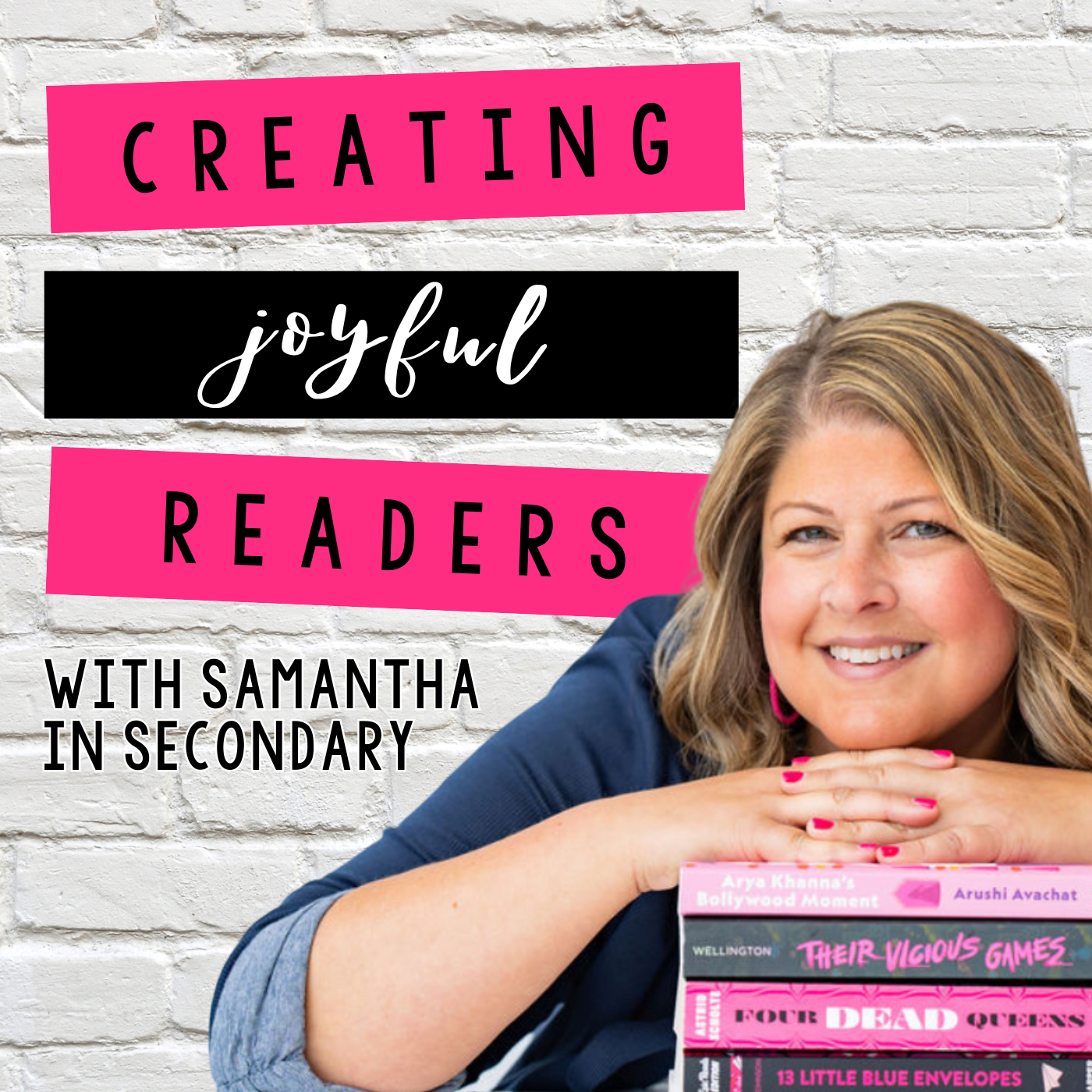
The Podcast
Creating Joyful Readers
It is possible to inspire a lifelong love of reading in secondary ELA students and that’s what the Creating Joyful Readers podcast is all about.
Join us every Monday as we dive into the latest in literacy research, talk about fresh Young Adult book recommendations, and chat fresh strategies to motivate your secondary students to love reading again.
Meet Your Host
Welcome! I’m Samantha, a veteran educator with 15 years of classroom experience and a Masters in Education, dedicated to transforming how students experience reading. My passion lies in empowering ELA teachers to foster joyful, independent readers in their classrooms.
Through this podcast, I’ll share the latest literacy research, practical tips, creative project ideas, and fresh book recommendations, all designed to help you ignite a love for reading in your students and make reading a delightful adventure, not a chore.
